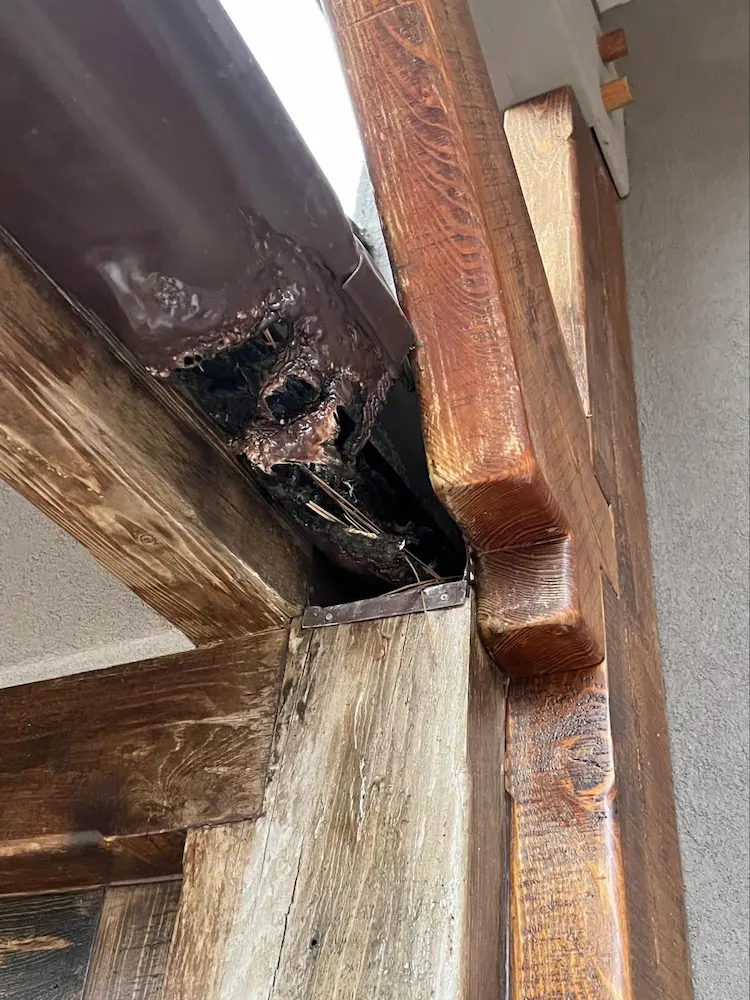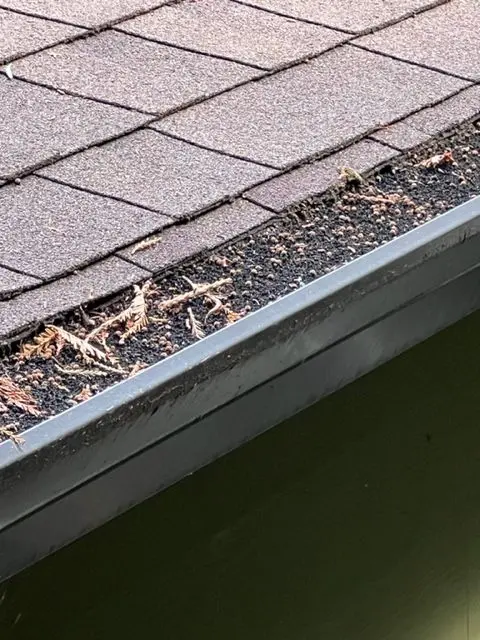Appearance
Gutters
Bottom line
Metal gutter covers on gutters attached directly below the roof drip edge protected by metal flashing offer the best mitigation from ember ignition exposures. Gutters and covers must be maintained free of combustible debris.
Overview
Gutters collect debris and embers during wildfires, which can ignite in close proximity to the roofline and carry flame to the underside of eaves. Metal gutter covers are important for preventing the buildup of combustible debris in gutters and to resist spread. Drip edge metal flashing is also important to protect the roof deck and fascia from igniting if debris that collects on top of a gutter cover ignites.
Gutter material
Metal
Metal gutters provide the most protection against ember-ignitions of debris that could build up in gutters during a wildfire. Winds that often accompany wildfires will rain debris and embers on even well maintained gutters. Metal is noncombustible and offers additional protection from spreading flames to the area below if debris were to ignite. However, an uncovered metal gutter alone is not by itself enough to protect a structure and could spread flames to a structure (e.g., flame impingement to a combustible fascia).
Metal gutters can be detected by tapping them or attempting to bend them. Unlike vinyl gutters, they are harder to the touch, resist bending, and have a hard sound when tapped (e.g., with a finger, monopole, or stick).
Vinyl
Vinyl gutters present significant risks during a wildfire, especially if a metal gutter cover is not also present. All uncovered gutters are vulnerable to windblown debris and embers landing in them and igniting during a wildfire. Vinyl gutters are made from polyvinyl chloride (PVC), which is a type of plastic that deforms as low as 170 deg F, which will cause the gutter to melt off the roof and drop its flaming contents onto whatever is below, including combustible vegetation or a deck, which can then impinge flames to the structure.
Plastic vinyl gutters can be detected by touching the gutter and/or attempting to bend it. It is light and soft to the touch and will bend, unlike metal gutters.
CBC Chapter 7A is silent on vinyl gutters. Vinyl gutters with a metal cover are currently considered compliant by Madronus, but vinyl gutters with vinyl/plastic covers are not compliant.
Wood
In some, particularly older, homes, redwood gutters may be found. To mitigate them, they should be removed and replaced with a metal gutter and metal gutter cover device.
No gutters
In some cases, especially for flat roofs, there may not be external gutters. These roofs often have a lip around the perimeter of the roof to channel water to a downspout location or a spill area. Like Complex Roof Locations, It’s important that these lips be made noncombustible to avoid debris and embers accumulating, igniting, and then spreading flames to the lip area.
Downspouts
We do not include downspouts in observations about gutters, but downspouts and their materials are not thought to be a concern from a wildfire safety standpoint.
Debris accumulation present
Accumulated plant debris is always an ember ignition hazard and must be removed and regularly maintained to prevent further build up. However, gutters are by nature prone to plant debris accumulation. During a wind-driven wildfire, plant debris can be blown from surrounding vegetation and accumulate even if gutters are normally well maintained.
Inspect the gutter area, if possible, or use a camera and monopole with remote shutter control or a drone to snap a photo. Another option is to feel with your hand in a few locations whether debris has accumulated.
 Plastic vinyl gutter damaged by plant debris that accumulated and ignited during a wildfire. All gutters should have metal gutter covers installed to prevent debris accumulation.
Plastic vinyl gutter damaged by plant debris that accumulated and ignited during a wildfire. All gutters should have metal gutter covers installed to prevent debris accumulation.
Metal drip edge present
Drip edge is metal angle flashing at the edge of the roof on the eave side that protects against in-gutter and top-of-gutter cover ignitions of debris by embers. Drip edges are common and are often integrated with the gutter, but some homes, particularly with older roofs, still lack them. Drip edges are a low cost retrofit option and should be installed on all structures (with gutters) that lack them.
Gutter covers present
Note the presence of gutter covers. Gutter covers are a critical component of preventing ignitions and reducing vulnerabilities to wildfires. A metal gutter cover can effectively mitigate a combustible gutter (e.g., vinyl).
Gutter cover material
Determine whether the gutter cover material is predominantly metal or of a plastic or other combustible material.
Products like GutterFoam FR are combustible. See Madronus’ list of Materials and Resources for examples of gutter covers.
 Combustible plastic (foam) gutter insert with accumulated debris that should be replaced with a noncombustible option. Product information included with these products indicate they have been treated with a fire retardant. Field testing demonstrated they were vulnerable to flaming exposures. Note the accumulation of debris on top of the device. Vegetative debris would be vulnerable to ignition by embers and once ignited, would provide a flaming exposure to the foam gutter device.
Combustible plastic (foam) gutter insert with accumulated debris that should be replaced with a noncombustible option. Product information included with these products indicate they have been treated with a fire retardant. Field testing demonstrated they were vulnerable to flaming exposures. Note the accumulation of debris on top of the device. Vegetative debris would be vulnerable to ignition by embers and once ignited, would provide a flaming exposure to the foam gutter device.